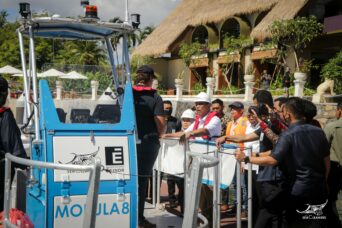Ocean’s plastic : where and why?
Plastic pollution
Science
20 March 2023
Which countries dump the most plastic into the ocean? Why do they do it?
What does this mean for plastic pollution solutions?
Here's a review of the science literature to better understand the magnitude and the drivers of ocean plastic pollution, so we can implement the most effective interventions to reduce it.

In contrast, Asia is the most populous continent, with 60% of the world’s population.
However, it is the high-income countries of the “North” that produce the most plastic waste per person: an American produces eight times more plastic waste than a Chinese.
Indeed, the United States generates on average 130 kilos of plastic waste per year and per capita, compared to 15 kilos in China and 43 kilos in France.
What we observe is that developed countries are more successful in treating or exporting waste to other countries. Meanwhile, many developing countries receive bulk exports but have not yet developed the infrastructure to process them, thus contributing more and more to ocean plastic pollution.
Thus, it is not only the consumption or even the production of plastics that would be the only data explaining marine plastic pollution from Asia: the mismanagement of these wastes is also at fault, whether they are generated locally or “inherited” from other countries.
Waste to Oceans in Focus
Published in 2021, the study by Meijier et al. has changed the knowledge of the global distribution of plastic pollution by taking into account another major parameter: river density.
It is well known that most of the plastic waste in our oceans comes from land-based sources. By weight, 70% to 80% is plastic transported from land to sea via rivers.
While it was previously thought that the majority of plastic only came from a dozen or so of the world’s “mega-rivers” such as the Yangtze in China or the Ganges in India, this new study has reshuffled the deck on which countries are the biggest contributors to ocean plastic pollution: 80% of the plastic pollution carried from rivers to the ocean is actually spread over a much larger number of rivers, 1,656 to be precise.
This finding has enormous implications for our understanding of the contribution of countries to ocean plastic pollution. The Philippines becomes, instead of China, the largest contributor to marine plastic pollution. It is followed by India, Malaysia and China. While Indonesia goes from the 2nd to the 5th place.
How can a “small” country with “only” 113.9 million inhabitants overtake China, with 10 times the population, as the largest contributor to global ocean plastic pollution, and be responsible for nearly 35% of all ocean plastic pollution?
The first factor is geographical: the Philippines is an archipelago of more than 7,000 islands, with a coastline of 36,289 kilometers and 4,820 plastic-emitting rivers, and where the majority of the population lives on the coastal edge. Seven of the top ten plastic-emitting rivers are in the Philippines: the Pasig River in the Philippines alone accounts for 6.4% of global riverine plastic production.
The second factor is the poor development of waste management infrastructure due to lack of investment. Without adequate infrastructure, the accumulated waste is either burned in the open air, with dramatic consequences for the health of local populations, or buried or dumped into the ocean.
A thorough understanding of these two factors is guiding the deployment of The SeaCleaners’ program strategy in Asia, starting with Indonesia.
In Bali, the issue of the river system is equally acute. Bali is one of the smallest islands in the Indonesian archipelago, but also one of the most affected by plastic pollution. 90% of the inhabitants live less than one kilometer from one of the 372 rivers that irrigate the island. This water network is an incredible wealth for vegetation and agriculture. Unfortunately, it is also an ideal means of transport for plastic waste… According to the organization Sungai Watch, about 33,000 tons of plastic enter Bali’s rivers each year, or about 90 tons per day.

Mobula 8 and MAPP to fight ocean plastic pollution where it is created.
Launched in October 2022 in Bali, Indonesia, MAPP (Mobula Against Plastic Pollution) is a global program to fight plastic pollution, which relies on the action of Mobula 8, the multipurpose clean-up boat in calm waters: rivers, mangroves, canals and port areas ….
This program is global because of:
The actors involved: it is a collaboration with the authorities, associations and local entrepreneurs,
The complementarity of the actions carried out.
Indeed, The SeaCleaners completes the curative action of waste collection by the Mobula 8 with a global approach:
– Waste management: creation with local actors of a value chain for a better waste management
– Sensitization of local communities for a sustainable change in behavior and training in better waste management
– Technical and financial assistance to improve waste management infrastructure
– Scientific research: satellite data collection during waste collection (thanks to our partner CLS, a subsidiary of CNES specialized in Earth observation)
The implementation of the MAPP program in Bali paves the way for the dissemination of this model on a large scale for better waste management locally, in developing countries. The conclusion of this article is an opportunity to remember that if the visible part of the ocean plastic pollution iceberg is located in Asia, it is also necessary that the countries of the North change their behavior towards the excessive consumption of plastic. It is too often what we throw away here, that ends up “over there”.
